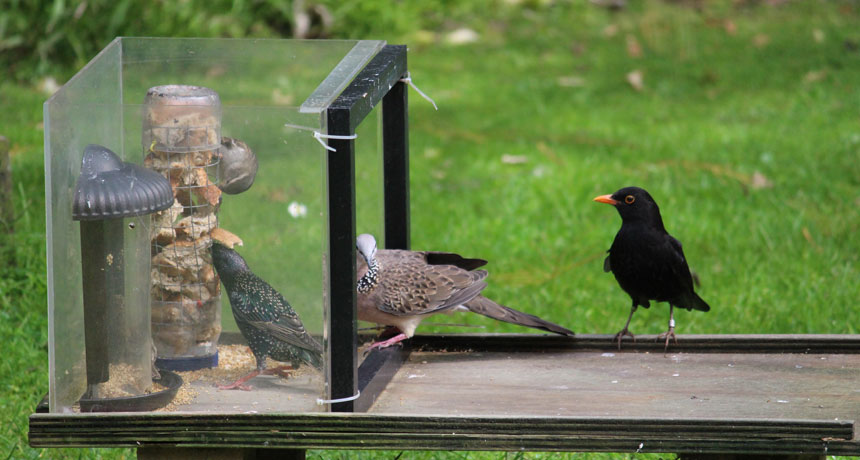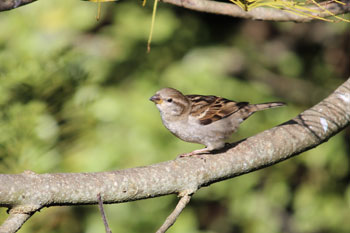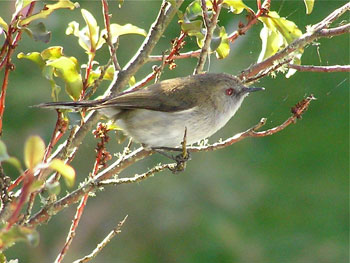The accidental experiment at your bird feeder
A backyard ornament might feed ecological bullies at the expense of native birds

These birds chowing down at a feeder in New Zealand all have one thing in common — they are all non-native species.
J. Galbraith
Bird feeders can bring nature right to your door. It’s nice to watch the feathered visitors flit around, pecking at seeds and sometimes setting up nests nearby. A bird feeder seems harmless. Feeding the birds might even feel virtuous. But a new study suggests we should take a close look at which birds are getting the grain.
Bird feeders may favor invasive species — species that are not originally from the area. Feeding these invaders may effectively push some native birds away from your yard and their former habitat.
A bird species can’t live somewhere if there’s nothing around to eat. Most cities might seem like a pretty poor choice of bird habitat. After all, many lack an abundance of trees and seeds. In an effort to help, well-meaning people often put out bird feeders.

So she asked 23 people living around her city if they would let her use their backyards for research. Galbraith sat in each yard in the morning for 10 minutes, carefully recording which birds were present and how many there were. Then, 11 of the participating homeowners were told to stock large bird feeders every morning with bread and seeds. The other 12 yards served as a control — that part of an experiment where nothing changes. Galbraith came back to each of the properties to count birds once a month for a year and a half.
When birds were offered daily food from a feeder, more of the winged visitors to these yards were members of invasive species. These included house sparrows and spotted doves. Native species didn’t benefit from the feeders, Galbraith found. Numbers of one native species, the grey warbler, even decreased compared to before feeding started. This suggests that the invasive sparrows and doves are pushing out native birds.
Galbraith and her colleagues published her findings May 19 in the Proceedings of the National Academy of Sciences.
“I don’t want people to stop feeding birds,” says James Reynolds. He’s an ornithologist at the University of Birmingham in England. “I just want them to think sensibly about what birds they are feeding.”

Her study also is a great model for how people can do real research in their own backyard.
“Even if you just look at a single garden, you could start by setting up a survey of what is there before you start feeding [the birds],” explains Galbraith. “Then you can start some kind of feeding and look at what happens.” She says that it could be any kind of food, as long as you feed and survey the birds regularly and consistently. Galbraith also notes that if you’re going to observe the birds, don’t get too complicated. Just pick one thing to test at a time.
Doing backyard ornithology is a great way to get to know local birds. Reynolds says the most important part is getting to know your birds beforehand by observing them carefully. “The more you can watch birds the better,” he advises. “You need to understand when birds are active and which are present. Once you get under the skin of a bird, the sky is the limit.”
Follow Eureka! Lab on Twitter
Power Words
(for more about Power Words, click here)
control A part of an experiment where there is no change from normal conditions. The control is essential to scientific experiments. It shows that any new effect is likely due only to the part of the test that a researcher has altered. For example, if scientists were testing different types of fertilizer in a garden, they would want one section of it to remain unfertilized, as the control. Its area would show how plants in this garden grow under normal conditions. And that give scientists something against which they can compare their experimental data.
invasive species (also known as aliens) A species that is found living, and often thriving, in an ecosystem other than the one in which it evolved. Some invasive species were deliberately introduced to an environment, such as a prized flower, tree or shrub. Some entered an environment unintentionally, such as a fungus whose spores traveled between continents on the winds. Still others may have escaped from a controlled environment, such as an aquarium or laboratory, and begun growing in the wild. What all of these so-called invasives have in common is that their populations are becoming established in a new environment, often in the absence of natural factors that would control their spread. Invasive species can be plants, animals or disease-causing pathogens. Many have the potential to cause harm to wildlife, people or to a region’s economy.
native Associated with a particular location; native plants and animals have been found in a particular location since recorded history began. These species also tend to have developed within a region, occurring there naturally (not because they were planted or moved there by people). Most are particularly well adapted to their environment.
ornithology The scientific study of birds. Experts who work in this field are known as ornithologists.